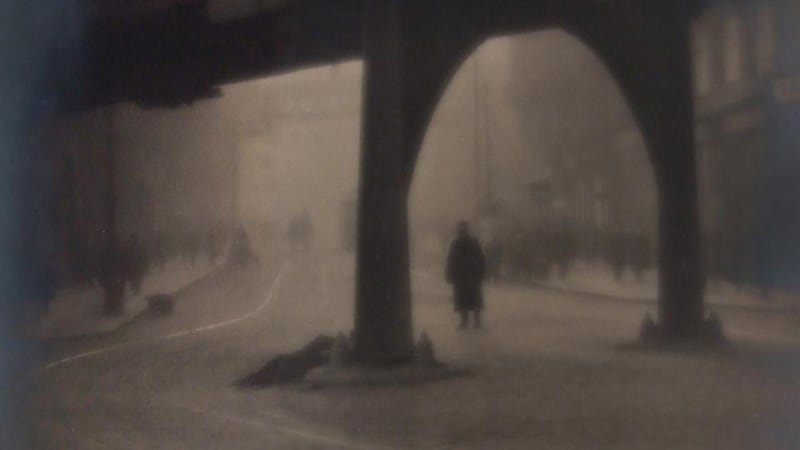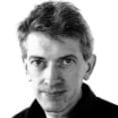Josef Sudek: Photographs (Gallery 1)
Douglas Hyde Gallery, Trinity College Dublin
*****

In his third year of military service during the first World War, Josef Sudek was badly injured by friendly fire when an artillery shell fell short during an offensive in Italy. He lost his right arm. Born in Kolin, close to Prague, in 1896, he had trained as a bookbinder before the war, but he was also a keen amateur photographer and took a camera with him into the army. His injury encouraged him to apply himself to photography more seriously – not an easy option given the cumbersome, large-format view camera he opted to carry and use. Professionally, he began to produce advertising photographs in the Pictorial style, which he found contrived and false, so he established a society dedicated to the promotion of modernist photography, though he later returned to aspects of the Pictorialist approach.
Sudek is popularly known as the Poet of Prague and is indelibly associated with the city. Through the decades he became a familiar presence in its streets and parks. The story goes that, on a visit to Italy in 1926, he was suddenly possessed by the need to go in search of the arm he had lost. Back in Prague, he said that he would never travel anywhere again, and turned his attention to his immediate surroundings, including his own studio and the city streets, nearby forests and the garden of a friend, architect Otto Rottmayer.
He stayed in Prague, as he had promised, through German occupation and soviet rule, until he died in 1976. His studio was, as a friend put it, “a kind of cultural oasis”, a haven for discussion, literature and music. He also built up a collection of books and LPs.
Making a photograph, he would set up his camera at his chosen location and wait, perhaps for hours, until the light was right. He liked contact prints of varying sizes, which, though never particularly big, are incredibly rich in tone and detail. They demand and reward close attention. In the 1950s, armed with a Kodak Panorama camera from the late 19th century, he began to make panoramic views of the city. They were exceptionally popular.
Virtually all the strands of his work are represented in the Douglas Hyde show, Director John Hutchinson’s swansong exhibition at the gallery. It is a suitably muted, even melancholy display, but there is nothing downhearted about it. The accompanying note suggests that the “photographs uphold the value of quiet contemplation and awareness of one’s surroundings”, which is certainly true. It is noticeable that Sudek was consistently drawn to what cannot quite be seen. Light makes each photograph, but the light is slowed and given almost physical substance by dust, mist, fog, smog and condensation, or arrangements of endlessly reflective and transparent surfaces.
One of his most extraordinary series is titled My Studio Window. The window is usually coated with condensation or perhaps a layer of misty rain, offering just a vague, fragmentary glimpse of an apple tree in the courtyard. In conventional terms, the photographs come close to not being there at all, but they are exceptionally atmospheric and evocative. Even when Sudek fixes things with absolute clarity, he has a knack for abstracting them. That is, their familiarity drains away and we see them as strange, even alien, though by no means threatening or ominous.
Until February 1st, douglashydegallery.com
Barbara Knezevic: Exquisite Tempo Sector
Temple Bar Gallery, Dublin
*****
Barbara Knezevic has made a mildly unsettling, disorientating environment in Exquisite Tempo Sector, accurately described as "an omnivorous selection of things acting together to call to mind a film set, a photographic shoot, retail and museum displays and other stagings of stuff in the world".
Wander in and you do get a sense that you are in the middle of a set, but it is impossible to say what kind of set. It all sends out mixed messages. Besides the aforementioned, there is the distinct, contradictory insinuation of natural therapies in the scents of burning candles, seawater, essential oils and the presence of handcrafts. Then there are several examples of the familiar, almost generic decorative house and atrium plant, Monstera deliciosa, with its shiny leaves.
Without being prescriptive about it, Knezevic addressees the way we read an environment, and how environments are designed, constructed and pitched to connect with us in particular ways. The rarefied museum display, for example, with its precious objects; the luxury goods retailer with its aura of privilege and affluence; the health spa, the hotel lobby and so on.
Smooth, glossy surfaces, select synthetic materials, meticulously fashioned objects of unclear purpose: all contribute to a feeling of calculated perfection. But then she undercuts this with, as she puts it, the additional element of time. The monumental candles gradually melt down in unruly mounds and dribbles of wax, water evaporates, and the plants grow according to their own rhythm. It's a big, complex affair, beautifully orchestrated, visually intriguing and conceptually rich, setting many ideas in motion. It follows on from Knezevic's The Last Thing on Earth at The Mac in Belfast last year and with it ranks as her best work to date.
Until January 28th, templebargallery.com
















